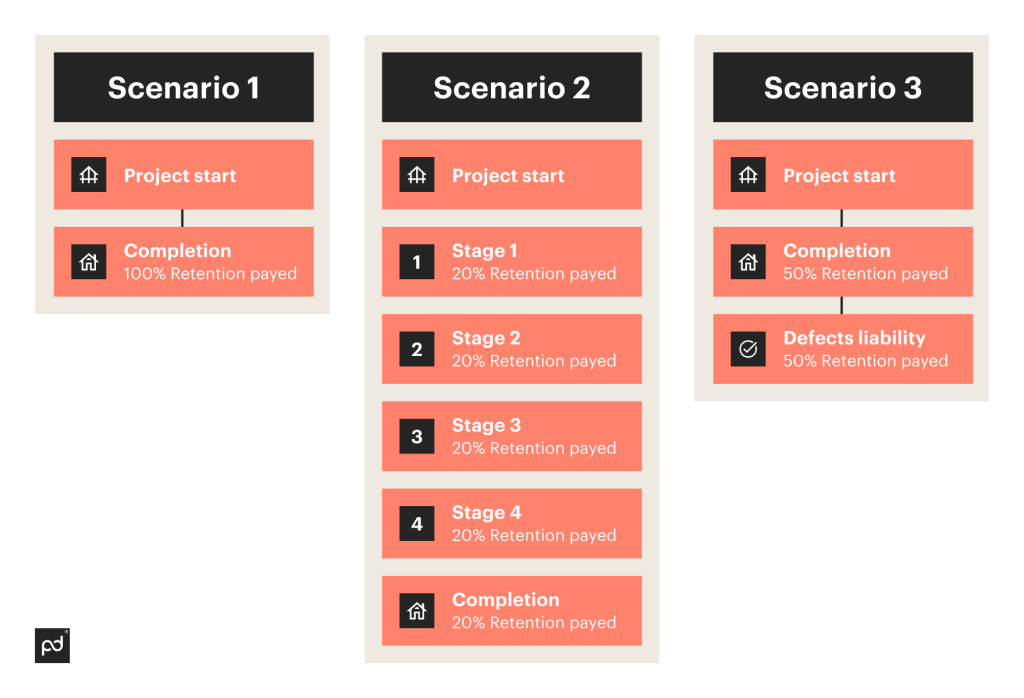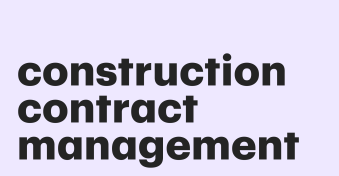Contract retention is a long-standing practice in the construction industry designed to cover property owners in case of damage or other issues.
However, retainage can burden contractors, so they must clearly understand how it works and how to mitigate its effects. We’ll look at all this and more in this comprehensive guide.
Key takeaways
- In construction, contract retention (or retainage) is a percentage of a contractor’s fee that’s held until they finish a project.
- Contract retention acts as a warranty for property owners. It ensures a contractor will complete a project to the agreed specifications.
- Retention laws vary from state to state. Owners and contractors should check the laws in their state before signing a contract.
- Retainage can cause cash flow issues for contractors, subcontractors, and suppliers. However, these can be managed with the right preparations.
What is retainage in construction?
Retention in construction is when a property owner or employer retains a percentage of a contractor’s fee (usually 5-10%) as security.
It’s different from an employee retention contract, which is a contract designed to incentivize an employee to stay with a company.
Details such as the retainage amount and when contractors will receive it should be included in a contract for services.
This is usually between the employer and the primary contractor.
The primary contractor may have a contract retention policy for subcontractors and suppliers.
For public construction projects, the amount of retainage is determined by state laws and varies from state to state.
For example, owners and primary contractors cannot retain more than 5% of the contract price in California. In Arizona, the maximum retainage is 10%.
The amount of retainage may be higher for private projects, although some states still cap retainage.
For instance, the maximum retainage allowed in Alabama is 5% for public projects and 10% for private projects.
What is the purpose of retainage?
Contractor retainage has been around for over 100 years in the US to safeguard owners and employers. The aim is to incentivize contractors to complete a job to the specified standard.
It also ensures they return to rectify any defects that arise within the defects liability period.
If contractors or subcontractors fail to come through, they forfeit their retention money.
So, a retention contract also provides funds for the owner to employ someone else to finish the job.
How long should contracts be retained?
The owner must pay retainage to the contractor (and they to the subcontractors) within the period specified in the contract.
This is often 30 days, depending on what the owner and the contractor have negotiated.
The contract retention period also depends on state laws.
For instance, in Arkansas, owners must pay retainage to the contractor within 30 days. In Louisiana, they must pay it within 45 days.
It’s important to note that the retention period may begin at different times in different states.
For example, in California, owners must pay retainage within 45 days of the “date of completion.”
In Louisiana, they must pay it within 45 days of “formal acceptance of the work.”
So, be sure to check the rules in your state.
What is retention payment?
Retention payment is a percentage of the total value of a contract between an owner and contractor or a contractor and subcontractor.
In some cases, retention payment is held until a project is complete. In other cases, retention payments are made as the project progresses.
Some retention payments may also be held until after the defects liability period.
For example, say a contractor agrees to complete a $50,000 project with a $5,000 (10%) retainage fee.

- In the first scenario, the contractor will receive the full $5,000 after completing the work (assuming no issues).
- In the second scenario, if the project is split into five stages, the contractor will receive a payment of $1,000 after each stage.
- In the third scenario, the contractor will receive $2,500 after completing the project and $2,500 after the defects liability period.
Retention payments reduce risk for owners by ensuring contractors meet their contractual obligations. They also reduce risk for primary contractors who rely on subcontractors and suppliers.
How do you calculate retention of payment?
Retainage is usually calculated as a percentage of the total cost of a project.
To calculate it accurately, you must ensure your project estimates are accurate.
Construction estimation software calculates construction costs automatically, giving you an accurate estimate of your total costs.
Based on this figure, you can calculate retention according to the model agreed in the contract: fixed or variable.
Fixed retention is when the same amount of money is withheld from each payment.
For example, if the contract stipulates five payments of $10,000 with a 5% retention rate, then $500 will be retained from each payment.
Variable retention is when the retention percentage is different for different project stages.
For instance, the percentage may be reduced from 10% to 5% when the project is halfway through.
Or, in some states, the retention rate is 5% for the first half of the project, after which no retainage may be held.
Example of a retention fee
Imagine a client hires a contractor to build a 2,500-square-foot home for $150 per square foot. The total cost is $375,000, and the retention rate is 10%.
The project will be completed in six stages, with 15% retainage applied to the first three stages and 5% to the final three stages (for a project average of 10%).
Retention will be paid after each stage is completed and signed off by the owner.
| Project stage | Cost (USD) | Retention rate | Amount retained |
|---|---|---|---|
| Foundation | $55,000 | 15% | $8,250 |
| Rough framing | $45,000 | 15% | $6,750 |
| Siding and roofing | $45,000 | 15% | $6,750 |
| First fix | $100,000 | 5% | $5,000 |
| Second fix | $95,000 | 5% | $4,750 |
| Landscaping | $35,000 | 5% | $1,750 |
| Total: | $375,000 | 10% | $37,500 |
4 ways retention payment can affect ongoing projects
Contract retention benefits employers. However, it can cause difficulties for contractors, subcontractors, and suppliers.
Below are four ways retention payment can affect ongoing projects.
Limits cash flow
Perhaps the most significant issue caused by retainage is that it limits a contractor’s cash flow.
If there is a delay in payment, they may be unable to buy new materials or pay employees.
The effects can also ripple down the supply chain.
Retention can be especially problematic when projects have tight profit margins.
The retention amount may exceed the projected profit, leaving contractors in the red until paid.
Impacts subcontractors and suppliers
It’s common for primary contractors to include retainage in their contracts with subcontractors and suppliers.
This means they can experience the same cash flow issues as primary contractors.
Suppliers and subcontractors must wait to receive retainage until the primary contractor receives their retention payment from the owner.
For suppliers and subcontractors who work at the beginning of a project, this can mean waiting months or even years for payment.
They have to complete other projects with a reduced cash reserve.
Clashes with mechanic’s liens
A mechanic’s lien is essential for contractors to secure payment.
However, if retainage is held until the end of the project or beyond, the deadline for filing for a lien can expire before retainage is due.
Contractors must apply for a lien prematurely and risk souring relations with the owner.
Or, wait and hope the owner pays the retention that’s due.
Some states do make exceptions for liens about retainage.
For example, contractors in Texas can file a Notice of Contractual Retainage to preserve their right to file a mechanic’s lien if they don’t receive the retention payment they’re owed.
This isn’t the case in every state, though.
Damages working relationships
Sometimes, contractors have to retain a higher amount from subcontractors and suppliers to cover the cost of retainage applied to them.
This can damage working relationships and even lead to legal action.
Retention can cause disputes between owners and contractors, resulting in legal expenses and soured relations.
Retainage in construction: tips to manage the impact and receive payment faster
Below are some tips to help you mitigate the adverse effects of retention in contracts and receive payment faster.
1. Study the contract carefully
Before you sign a construction contract, ensure you understand the retainage amount and when you will receive it.
If the retention fee will affect your cash flow, consider if there’s another project you could take on with lower retainage.
It’s also helpful to familiarize yourself with your state’s retention laws to know if the retention clause is legal.
2. Streamline your billing process
An efficient billing process means sending invoices and receiving retention payments faster.
Create standard operating procedures for your billing process, and consider using automated accounting software.
That way, your invoices will be accurate and timely, so you should receive payments without delay.
3. Prepare for retainage in advance
Make sure you include retainage in your project budget.
Also, use cashflow forecasting tools to study the impact of retainage and ensure you’ll have enough capital to see you through the project.
You could also open a business savings account (if you don’t already have one) and put some money aside to cover you until you receive the retention money.
4. Consider contractor financing
If the worst comes to the worst and retainage leaves you in the red, you can apply for contractor financing.
This will tide you over until you receive the retainage you’re due.
Various options include lines of credit, credit cards, and project-based material financing.
Each option has pros and cons, so research them beforehand.
Set up retention policies for your contracts with PandaDoc contract management software
In most cases, construction contracts include a retention clause.
This details the retainage to be held and how and when this money will be paid.
With PandaDoc contract management software, adding a retention clause to your contract is easy. PandaDoc has a range of pre-built templates to choose from.
Plus, you can customize your contracts with a library of pre-approved clauses.
You can store all your contracts and other documents in a single, searchable Document Repository. Moreover, PandaDoc’s Contract Negotiations feature lets you view and comment on contract changes in a shared workflow 一 allowing ease of negotiating retention.
You can also sign contracts and other documents electronically, saving everyone time.
Request a demo and see how PandaDoc could work for you!
Frequently asked questions
-
The retention amount due should be listed on the interim and completion certificates.
Employers should pay retention within the period specified in the contract, assuming the conditions for release are met (for instance, the work has been formally accepted). If they don’t, they may be penalized, and you may be able to take legal action.
-
Retention alternatives vary by state but may include:
-
- Escrow accounts
-
- Deposit accounts
-
- Project bank accounts
-
- Retention bonds
-
- Performance bonds
-
- Trust funds
-
Disclaimer
PandaDoc is not a law firm, or a substitute for an attorney or law firm. This page is not intended to and does not provide legal advice. Should you have legal questions on the validity of e-signatures or digital signatures and the enforceability thereof, please consult with an attorney or law firm. Use of PandaDoc services are governed by our Terms of Use and Privacy Policy.


